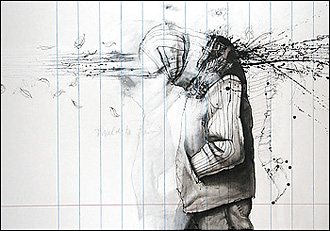'Migration': Universal Truths
 Michael O'Sullivan - Washington Post Michael O'Sullivan - Washington Post
go to original


| | One of the show's most powerful pieces is "Maldita Brisa III" by Gerard Ellis (Dominican Republic). (Gerard Ellis) |
Multi-artist exhibitions built on a single broadly interpreted theme too often deserve the description "all over the map." Normally, that's not a compliment, but with the Association of Ibero-American Cultural Attaches' 16th annual art salon, the phrase is fitting and flattering.

Maps figure prominently throughout "Migration: La Diaspora," which addresses the theme of movement from one culture to another. That's true in a series of five photo-based portraits by artist Marianela Salgado (Costa Rica) collaged atop maps. But it's also true in "Human Settlements," a painting by Evangelina Elizondo (Argentina) that features an array of small, anonymous figures that have been positioned, like playing pieces from the game Risk, against an abstract backdrop that is part map, part board game.

Both works embody the show's central message. In a nutshell, it's that the issue of migration is not just political, but personal. For every map, for every fragment of a national flag, for every abstract reference to geography, there's a human being involved.

In almost every case except Salgado's, the features of their faces are blurred, obscured, generic or absent, emphasizing not their individuality, but our common humanity. Take "Hombre" by Julio Perez (Spain), featuring a seated Everyman whose face is distorted beyond recognition in the manner of a Francis Bacon painting. Or how about "Take Off" by Juliana Moncayo (Colombia)? On the right in her flat, posterlike diptych is a queue of human silhouettes, apparently waiting to be evacuated by air from some unnamed trouble spot. On the left is an expanse of sky, empty but for a flock of birds. They represent, presumably, the universal yearning for freedom -- or a better life.

One of the show's most powerful pieces is "Maldita Brisa III" by Gerard Ellis (Dominican Republic). Echoing Moncayo's none-too-subtle allusion to the kind of political winds that carry migrating men, like birds, away from their homelands, the title of Ellis's painting translates to "Damned Breeze." Yet his work rejects the promise and hope suggested by her painting. In "Maldita," a solitary, hooded figure moves across the canvas, painted to look like a sheet of ruled composition paper. Here, the somewhat underdressed man lowers his head against a far stiffer gust than the one that carries Moncayo's migrating subjects. In fact, it suggests a violent burst of gunfire to the head, along with a spatter of blood and brain matter.

The experience of this particular immigrant is an extreme example in a show that offers views of cross-cultural flow as varied as the artists involved, many of whom are themselves immigrants.

Chilean-born Joan Belmar, for instance, lives and works in Washington, as does Katya Romero of Ecuador; Venezuela's Sara Nu¿ez is based in Vienna, Austria; Ellis in New York City. Of the association's 21 member nations (which include Spain, Portugal and the countries of Latin America), only Bolivia, Cuba, Guatemala and Nicaragua are not represented this year.

But the preponderance of immigrants among the show's artists is completely coincidental. That's according to Patricia Abdelnour, the Venezuelan Embassy's cultural attache and the association's vice president. She chalks it up to globalization and the rootlessness of the contemporary human condition.

In the end, what ties the art in "Migration," though, is a shared sensibility. It's one underscored by the recurrence of the figure, by the slight but significant edge of the personal over the political. "Migration" is not about the places people come from, but the people who come from them. At once faceless and universal, they remind viewers that this nation has always been a haven for folks from someplace else.

Migration: La Diaspora Through Feb. 2 at the Mexican Cultural Institute, 2829 16th St. NW (Metro: Columbia Heights) Info:202-728-1628. http://www.iaculturalattaches.org. Hours: Open Monday-Friday from 9:30 to 1 and from 3 to 6:30. Admission: Free. |



